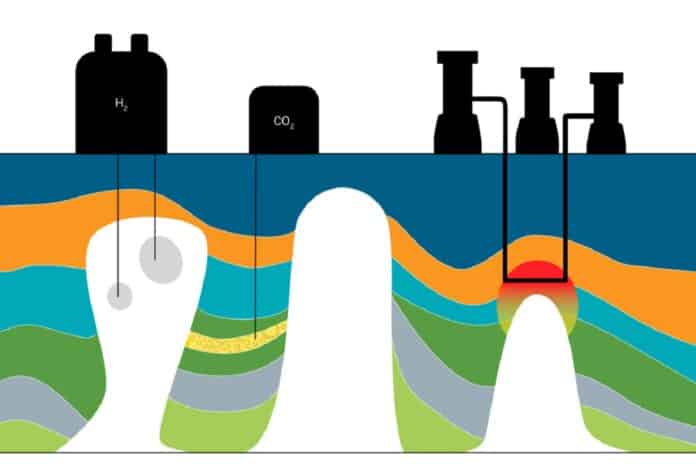A common ingredient – salt – could have a big role to play in the energy transition to lower-carbon energy sources. Salt tectonics can play a role in key energy transition technologies, such as energy storage as gas in salt caverns, CO2 storage, and geothermal energy. A new highlights the potential for development in salt-bearing basins, such as hydrogen storage caverns, porous media CO2 storage sites, and enhanced geothermal energy potential. To exploit these resources, a deeper understanding of the internal composition, geometry, and evolution of salt structures and their surrounding sediments is needed. This new understanding will help optimize design, reduce geotechnical risk, and improve efficiency for energy transition technologies.
Researchers at The University of Texas at Austin’s Bureau of Economic Geology have found how large underground salt deposits might be used as hydrogen storage tanks to transfer heat to geothermal facilities and to impact CO2 storage. It also demonstrates how industries with current salt expertise, such as solution mining, salt mining, and oil and gas exploration, may help.
Lead author Oliver Duffy, a research scientist at the bureau, said, “We see potential in applying knowledge and data gained from many decades of research, hydrocarbon exploration, and mining in salt basins to energy transition technologies. Ultimately, a deeper understanding of how salt behaves will help us optimize design, reduce risk, and improve the efficiency of a range of energy transition technologies.”
Study co-author Lorena Moscardelli, the head of the bureau’s State of Texas Advanced Resource Recovery (STARR) program, said, “These structures and their surrounding geology offer a number of opportunities for energy development and emissions management.” Salt significantly impacts the formation of the Earth’s subsurface layers. Geologic processes readily strain it into complex and huge deposits, with some underground salt formations higher than Mount Everest.
She also said, “The co-location of surface infrastructure, renewable energy potential, favorable subsurface conditions, and proximity to markets is key to plan for subsurface hydrogen storage. STARR is currently engaged with emerging energy opportunities in West Texas that involve hydrogen and carbon capture, utilization, and storage potential for the region.”
According to Bureau Director Scott Tinker, several options must be carefully investigated since salt has a role to play in the creation of new energy resources. He said that the bureau’s researchers are essential in achieving this.
He said, “Bureau researchers have been studying subsurface salt formations for many decades. For their role in hydrocarbon exploration, as part of the Strategic Petroleum Reserve, for storage of natural gas, and now for their potential to store hydrogen. That’s the remarkable thing about great research. It just keeps evolving, improving, and finding new applications.”
Oil refineries and the petrochemical industries have successfully employed salt domes as hydrogen storage containers. The article suggests that these salt forms might be used to store hydrogen headed for energy generation. Furthermore, the porous rock that surrounds them may be employed as a long-term repository for CO2 emissions. The study discusses the possible advantages of combining CO2 storage and “blue hydrogen” synthesis from natural gas. The CO2 emissions from the manufacturing process might be sent to the nearby rock for long-term storage while the hydrogen is sent to salt caverns.
The Texas Gulf Coast is particularly well-suitable for this form of combined production and storage, according to the researchers, with its many salt domes surrounded by porous sedimentary rock.
The study additionally addresses how salt can increase the use of cutting-edge geothermal technologies. The researchers demonstrate how the industry might leverage salt’s capacity to readily transport heat from warmer underlying rocks to generate geothermal electricity, even if the sector is still beginning.
Journal reference:
- Oliver Duffy, Gillian Apps, et al.The Role of Salt Tectonics in the Energy Transition: An Overview and Future Challenges.Tektonika. DOI: 10.55575/tektonika2023.1.1.11
